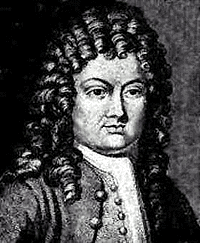A Short Account of the History of Mathematics
by W.W. Rouse Ball
Brook Taylor
Additional Information
- Year Published: 1908
- Language: English
- Country of Origin: England
- Source: Ball, W.W.R. (1908). A Short Account of the History of Mathematics. London, New York: Macmillan.
-
Readability:
- Flesch–Kincaid Level: 12.0
- Word Count: 493
- Genre: History
- Keywords: biography
- ✎ Cite This
Downloads

Brook Taylor, born at Edmonton on August 18, 1685, and died in London on December 29, 1731, was educated at St. John's College, Cambridge, and was among the most enthusiastic of Newton's admirers. From the year 1712 onwards he wrote numerous papers in the Philosophical Transactions, in which, among other things, he discussed the motion of projectiles, the centre of oscillation, and the forms taken by liquids when raised by capillarity. In 1719 he resigned the secretaryship of the Royal Society and abandoned the study of mathematics. His earliest work, and that by which he is generally known, is his Methodus Incrementorum Directa et Inversa, published in London in 1715. This contains [prop. 7] a proof of the well-known theorem
f (x + h) = f (x) + hf′ (x) + h2/2! f ″(x) + ... ,
by which a function of a single variable can be expanded in powers of it. He does not consider the convergency of the series, and the proof which involves numerous assumptions is not worth reproducing. The work also includes several theorems on interpolation. Taylor was the earliest writer to deal with theorems on the change of the independent variable; he was perhaps the first to realize the possibility of a calculus of operation, and just as he denotes the nth differential coefficient of y by yn so he uses y-1 to represent the integral of y; lastly, he is usually recognized as the creator of the theory of finite differences.
The applications of the calculus to various questions given in the Methodus have hardly received that attention they deserve. The most important of them is the theory of the transverse vibrations of strings, a problem which had baffled previous investigators. In this investigation Taylor shews that the number of half-vibrations executed in a second is
![]()
where L is the length of the string, N its weight, P the weight which stretches it, and D the length of a seconds pendulum. This is correct, but in arriving at it he assumes that every point of the string will pass through its position of equilibrium at the same instant, a restriction which D'Alembert subsequently shewed to be unnecessary. Taylor also found the form which the string assumes at any instant.
The Methodus also contains the earliest determination of the differential equation of the path of a ray of light when traversing a heterogeneous medium; and, assuming that the density of the air depends only in its distance from the earth's surface, Taylor obtained by means of quadratures the approximate form of the curve. The form of the catenary and the determination of the centres of oscillation and percussion are also discussed.
A treatise on perspective by Taylor, published in 1719, contains the earliest general enunciation of the principle of vanishing points; though the idea of vanishing points for horizontal and parallel lines in a picture hung in a vertical plane had been enunciated by Guido Ubaldi in his Perspectivae Libri, Pisa, 1600, and by Stevinus in his Sciagraphia, Leyden, 1608.